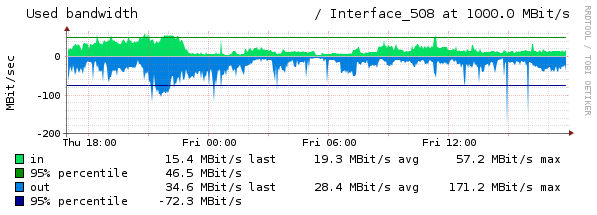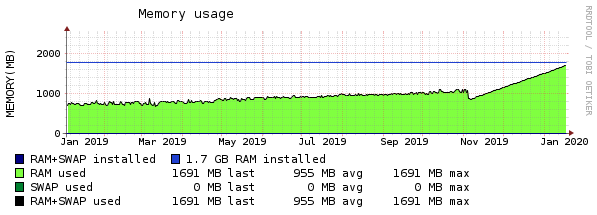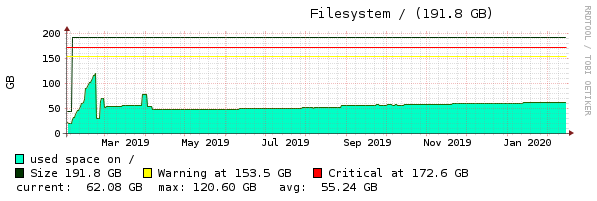|
|
Sponsored Content
Top Forums
UNIX for Advanced & Expert Users
Nearly Random, Uncorrelated Server Load Average Spikes
Post 303044127 by stomp on Friday 14th of February 2020 12:23:07 PM
|
|
10 More Discussions You Might Find Interesting
1. UNIX for Advanced & Expert Users
we have an unix system which has
load average normally about 20.
but while i am running a particular unix batch which performs heavy
operations on filesystem and database average load
reduces to 15.
how can we explain this situation?
while running that batch idle cpu time is about %60-65... (0 Replies)
Discussion started by: gfhgfnhhn
0 Replies
2. UNIX for Dummies Questions & Answers
Hello all, I have a question about load averages.
I've read the man pages for the uptime and w command for two or three different flavors of Unix (Red Hat, Tru64, Solaris). All of them agree that in the output of the 2 aforementioned commands, you are given the load average for the box, but... (3 Replies)
Discussion started by: Heathe_Kyle
3 Replies
3. UNIX for Dummies Questions & Answers
Hello, Here is the output of top command. My understanding here is,
the load average 0.03 in last 1 min, 0.02 is in last 5 min, 0.00 is in last 15 min.
By seeing this load average, When can we say that, the system load averge is too high?
When can we say that, load average is medium/low??... (8 Replies)
Discussion started by: govindts
8 Replies
4. Solaris
Hi,
i have installed solaris 10 on t-5120 sparc enterprise.
I am little surprised to see load average of 2 or around on this OS.
when checked with ps command following process is using highest CPU. looks like it is running for long time and does not want to stop, but I do not know... (5 Replies)
Discussion started by: upengan78
5 Replies
5. UNIX for Dummies Questions & Answers
Hello AlL,..
I want from experts to help me as my load average is increased and i dont know where is the problem !!
this is my top result :
root@a4s # top
top - 11:30:38 up 40 min, 1 user, load average: 3.06, 2.49, 4.66
Mem: 8168788k total, 2889596k used, 5279192k free, 47792k... (3 Replies)
Discussion started by: black-code
3 Replies
6. UNIX for Advanced & Expert Users
Hi ,
I am using 48 CPU sunOS server at my work.
The application has facility to check the current load average before starting a new process to control the load.
Right now it is configured as 48. So it does mean that each CPU can take maximum one proces and no processe is waiting.
... (2 Replies)
Discussion started by: kumaran_5555
2 Replies
7. Solaris
NPROC USERNAME SWAP RSS MEMORY TIME CPU
320 oracle 23G 22G 69% 582:55:11 85%
47 root 148M 101M 0.3% 99:29:40 0.3%
53 rafmsdb 38M 60M 0.2% 0:46:17 0.1%
1 smmsp 1296K 5440K 0.0% 0:00:08 0.0%
7 daemon ... (2 Replies)
Discussion started by: snjksh
2 Replies
8. UNIX for Dummies Questions & Answers
Hi,
I am getting a high load average, around 7, once an hour. It last for about 4 minutes and makes things fairly unusable for this time.
How do I find out what is using this. Looking at top the only thing running at the time is md5sum.
I have looked at the crontab and there is nothing... (10 Replies)
Discussion started by: sm9ai
10 Replies
9. UNIX for Dummies Questions & Answers
how load average is calculated and what exactly is it
difference between cpu% and load average (9 Replies)
Discussion started by: robo
9 Replies
10. Programming
Here we go....
Preface:
..... so in a galaxy far, far, far away from commercial, data sharing corporations.....
For this project, I used the ESP-WROOM-32 as an MQTT (publish / subscribe) client which receives Linux server "load averages" as messages published as MQTT pub/sub messages.... (6 Replies)
Discussion started by: Neo
6 Replies
LEARN ABOUT NETBSD
groff_www
GROFF_WWW(7) Miscellaneous Information Manual GROFF_WWW(7) NAME
groff_www - groff macros for authoring web pages SYNOPSIS
groff -mwww [ options ] file ... DESCRIPTION
This manual page describes the GNU -mwww macro package, which is part of the groff document formatting system. The manual page is very a basic guide, and the html device driver (grohtml) has been completely rewritten but still remains as in an alpha state. It has been included into the distribution so that a lot of people have a chance to test it. Note that this macro file will be automatically called (via the troffrc file) if you use -Thtml. To see the hyperlinks in action, please format this man page with the grohtml device. Here is a summary of the functions found in this macro set. .JOBNAME split output into multiple files .HX automatic heading level cut off; $1 point for sections/headers .BCL specify colours on a web page .BGIMG specify background image .URL create a url using two parameters .FTP create an ftp reference .MTO create a html email address .FTP create an ftp reference .TAG generate an html name .IMG include an image file .PIMG include png image .MPIMG place png on the margin and wrap text around it .HnS begin heading .HnE end heading .LK emit automatically collected links. .HR produce a horizontal rule .NHR suppress automatic generation of rules. .HTL only generate HTML title .HEAD add data to <head> block .ULS unorder list begin .ULE unorder list end .OLS ordered list begin .OLE ordered list end .DLS definition list begin .DLE definition list end .LI insert a list item .DC generate a drop capital .HTML pass an html raw request to the device driver .CDS code example begin .CDE code example end Output of the pic, eqn, refer, and tbl preprocessors is acceptable as input. REQUESTS
.JOBNAME filename Split output into multiple HTML files. A file is split whenever a .SH or .NH 1 is encountered. Its argument is the file stem name for future output files. This option is equivalent to grohtml's -j option. .HX n Specify the cut off depth when generating links from section headings. For example, a parameter of 2 would cause grohtml to gener- ate a list of links for .NH 1 and .NH 2 but not for .NH 3. Whereas .HX 0 will tell grohtml that no heading links should be created at all. Another method for turning automatic headings off is by issuing the the command line switch -P-l to groff. .BCL foreground background active not-visited visited This macro takes five parameters: foreground, background, active hypertext link, hypertext link not yet visited, and visited hyper- text link colour. .BGIMG imagefile the only parameter to this macro is the background image file. .URL url [description] [after] generates a URL using either one, two or three arguments. The first parameter is the actual URL, the second is the name of the link, and the third is optional stuff to be printed immediately afterwards. If description and after are absent then the url becomes the anchor text. Hyphenation is disabled while printing the actual URL; explicit breakpoints should be inserted with the : escape. Here is how to encode foo <http://foo.org/>: .URL http://:foo.:org/ foo : If this is processed by a device other than -Thtml it appears as: foo <http://foo.org>: The URL macro can be of any type; for example we can reference Eric Raymond's pic guide <pic.html> by: .URL pic.html "Eric Raymond's pic guide" .MTO address [description] [after] Generate an email html reference. The first argument is mandatory as the email address. The optional second argument is the text you see in your browser If an empty argument is given, address is used instead. An optional third argument is stuff printed immedi- ately afterwards. Hyphenation is disabled while printing the actual email address. For example, Joe User <joe@user.org> was achieved by the following macro: .MTO joe@user.org "Joe User" Note that all the URLs actually are treated as consuming no textual space in groff. This could be considered as a bug since it causes some problems. To circumvent this, www.tmac inserts a zero-width character which expands to a harmless space (only if run with -Thtml). .FTP url [description] [after] indicates that data can be obtained via ftp. The first argument is the url and the second is the browser text. A third argument, similar to the macros above, is intended for stuff printed immediately afterwards. The second and the third parameter are optional. Hyphenation is disabled while printing the actual URL. As an example, here the location of the GNU ftp server <ftp://ftp.gnu.org/>. The macro example above was specified by: .FTP ftp://:ftp.gnu.org/ "GNU ftp server" . .TAG name Generates an html name tag from its argument. This can then be referenced using the URL <2> macro. As you can see, you must pre- cede the tag name with # since it is a local reference. This link was achieved via placing a TAG in the URL description above; the source looks like this: .TP .B URL generates .TAG URL a URL using either two or three arguments. ... .IMG [-R|-L|-C] filename [width] [height] Include a picture into the document. The first argument is the horizontal location: right, left, or center (-R, -L, or -C). Align- ment is centered by default (-C). The second argument is the filename. The optional third and fourth arguments are the width and height. If the width is absent it defaults to 1 inch. If the height is absent it defaults to the width. This maps onto an html img tag. If you are including a png image then it is advisable to use the PIMG macro. .PIMG [-R|-L|-C] filename [width [height]] Include an image in PNG format. This macro takes exactly the same parameters as the IMG macro; it has the advantage of working with postscript and html devices also since it can automatically convert the image into the EPS format, using the following programs of the netpbm package: pngtopnm, pnmcrop, and pnmtops. If the document isn't processed with -Thtml it is necessary to use the -U option of groff. .MPIMG [-R|-L] [-G gap] filename [width [height]] Place a PNG image on the margin and wrap text around it. The first parameters are optional. The alignment: left or right (-L or -R) specifies the margin where the picture is placed at. The default alignment is left (-L). Optionally, -G gap can be used to arrange a gap between the picture and the text that wraps around it. The default gap width is zero. The first non-optional argument is the filename. The optional following arguments are the width and height. If the width is absent it defaults to 1 inch. If the height is absent it defaults to the width. Example: .MPIMG -L -G 2c foo.png 3c 1.5c The height and width may also be given as percentages. The PostScript device calculates the width from the .l register and the height from the .p register. For example: .MPIMG -L -G 2c foo.png 15% .HnS n Begin heading. The numeric heading level n is specified by the first parameter. Use this macro if your headings contain URL, FTP or MTO macros. Example: .HnS 1 .HR GNU Troff .URL http://groff.ffii.org (Groff) -- a .URL http://www.gnu.org/ GNU project. Hosted by .URL http://ffii.org/ FFII . .HR .HnE In this case you might wish to disable automatic links to headings. This can be done via -P-l from the command line. .HnE End heading. .LK Force grohtml to place the automatically generated links at this position. If this manual page has been processed with -Thtml those links can be seen right here. .HR Generate a full-width horizontal rule for -Thtml. No effect for all other devices. .NHR Suppress generation of the top and bottom rules which grohtml emits by default. .HTL Generate an HTML title only. This differs from the TL macro of the ms macro package which generates both an HTML title and an <H1> heading. Use it to provide an HTML title as search engine fodder but a graphic title in the document. The macro terminates when a space or break is seen (.sp, .br). .HEAD Add arbitrary HTML data to the <head> block. Ignored if not processed with -Thtml. Example: .HEAD "<link rel=""icon"" type=""image/png"" href=""http://foo.org//bar.png""/>" .HTML All text after this macro is treated as raw html. If the document is processed without -Thtml then the macro is ignored. Inter- nally, this macro is used as a building block for other higher-level macros. For example, the BGIMG macro is defined as .de BGIMG . HTML <body background=$1> .. .DC l text [color] Produce a drop capital. The first parameter is the letter to be dropped and enlarged, the second parameter text is the ajoining text whose height the first letter should not exceed. The optional third parameter is the color of the dropped letter. It defaults to black. .CDS Start displaying a code section in constant width font. .CDE End code display SECTION HEADING LINKS
By default grohtml generates links to all section headings and places these at the top of the html document. (See LINKS <2> for details of how to switch this off or alter the position). LIMITATIONS OF GROHTML
tbl information is currently rendered as a PNG image. FILES
/usr/share/tmac/www.tmac SEE ALSO
groff(1), troff(1) grohtml(1), netpbm(1) AUTHOR
grohtml was written by Gaius Mulley <gaius@glam.ac.uk> BUGS
Report bugs to the Groff Bug Mailing List <bug-groff@gnu.org>. Include a complete, self-contained example that will allow the bug to be reproduced, and say which version of groff you are using. Groff Version 1.19.2 February 6, 2006 GROFF_WWW(7)



